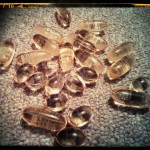 Gamma-linolenic acid (GLA, C18:3 (n-6)) is a fatty acid that is synthesised in humans from the essential fatty acid linoleic acid (LA, C18:2 (n-3)). Addition of GLA to the diet of humans can reduce inflammation in conditions such as rheumatoid arthritis and dermatitis because its metabolite, dihomo-γ-linolenic acid (DGLA, C20:3 (n-6)) is able to inhibit the inflammatory pathway caused by arachidonic acid (AA, C20:4 (n-6)). Gamma-linolenic acid is a precursor for AA, but although inflammatory cells such as neutrophils contain the elongase enzyme necessary for the conversion of GLA to DGLA, they do not contain the desaturase enzyme for the synthesis of AA, which explains the beneficial effects of GLA supplementation. However, outside of these cells supplementation of GLA can increase AA levels in other tissues such as the plasma which may have consequences for increased platelet aggregation caused by AA accumulation.
Gamma-linolenic acid (GLA, C18:3 (n-6)) is a fatty acid that is synthesised in humans from the essential fatty acid linoleic acid (LA, C18:2 (n-3)). Addition of GLA to the diet of humans can reduce inflammation in conditions such as rheumatoid arthritis and dermatitis because its metabolite, dihomo-γ-linolenic acid (DGLA, C20:3 (n-6)) is able to inhibit the inflammatory pathway caused by arachidonic acid (AA, C20:4 (n-6)). Gamma-linolenic acid is a precursor for AA, but although inflammatory cells such as neutrophils contain the elongase enzyme necessary for the conversion of GLA to DGLA, they do not contain the desaturase enzyme for the synthesis of AA, which explains the beneficial effects of GLA supplementation. However, outside of these cells supplementation of GLA can increase AA levels in other tissues such as the plasma which may have consequences for increased platelet aggregation caused by AA accumulation.
Because eicosapentanoic acid (EPA, C20:5 (n-3)) shows inhibitory effects on the conversion of AA by inhibition of the delta-5-desatuarte enzyme, researchers1 have investigated the supplementation of a combination of GLA and EPA on the formation of AA. Four adult volunteers were assigned to consume the control diet, and supplement with 3.0g/d of GLA from borage oil for 21 days. Twelve healthy volunteers were then assigned to consume the same control diet but supplement with 3.0g/d of GLA from borage oil and 3.0g/d of EPA from fish oil for 21 days. The fish oil capsules also contained 1.4 g/d of docosahexanoic acid (DHA, C22:6 (n-3)). The results showed that EPA and DGLA serum levels in the GLA and EPA group increased significantly, but there was no rise in the levels of AA. However, in contrast the GLA only group showed increases in both DGLA as well as those of AA within the 3 week period.
In addition, both EPA and DGLA in neutrophils increased in response to supplementation with GLA and EPA, but the AA did not change from baseline. Supplementation of GLA alone in contrast resulted in an increase in just DGLA. After a two week washout period, serum levels of EPA had returned to normal in the EPA and GLA group. Previous work by the same authors also showed that in the control group, GLA and AA levels returned to baseline two weeks after withdrawal of supplemental GLA. These results support the idea that supplements of GLA are able to raise AA levels in plasma outside of inflammatory cells such as neutrophils, but that addition of EPA inhibits that accumulation of AA. However, there is no evidence to suggest that the increased levels of AA seen with GLA supplementation are deleterious to the health and it is unclear as to what consequences the increased levels of AA may have.
 Figure 1. Synergism between essential fats. Possible mechanisms by which eicosapentanoic acid (EPA) provides benefits against inflammation in addition to those from γ-linolenic acid (GLA) alone, by blocking the conversion of dihomo-γ-linolenic acid (DGLA) to arachidonic acid (AA) in the circulation.
Figure 1. Synergism between essential fats. Possible mechanisms by which eicosapentanoic acid (EPA) provides benefits against inflammation in addition to those from γ-linolenic acid (GLA) alone, by blocking the conversion of dihomo-γ-linolenic acid (DGLA) to arachidonic acid (AA) in the circulation.
RdB
